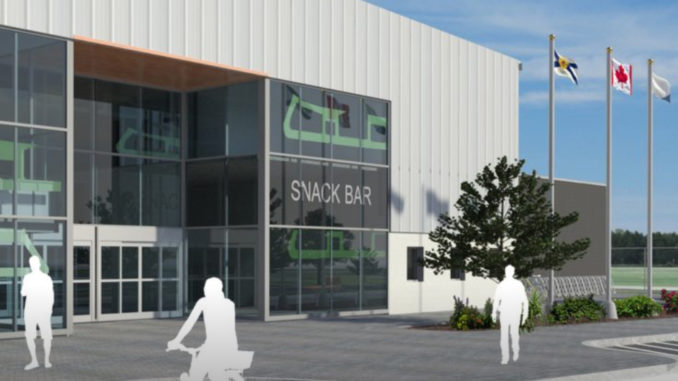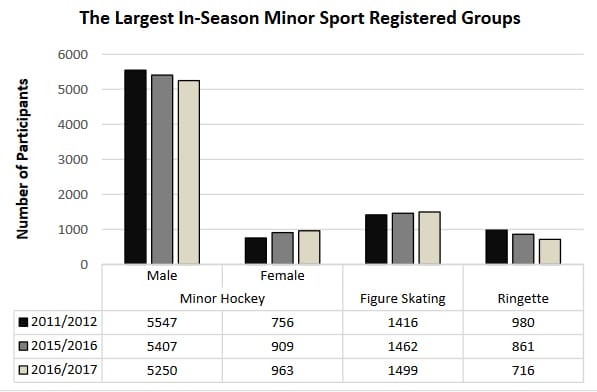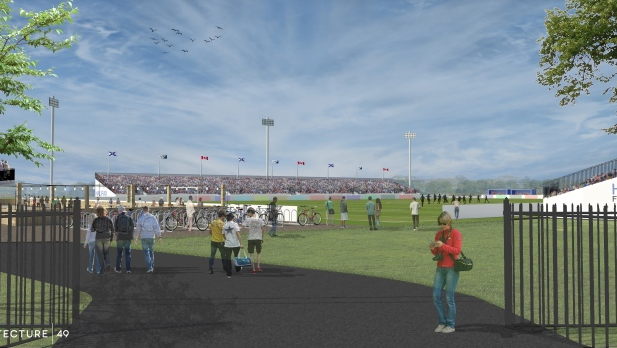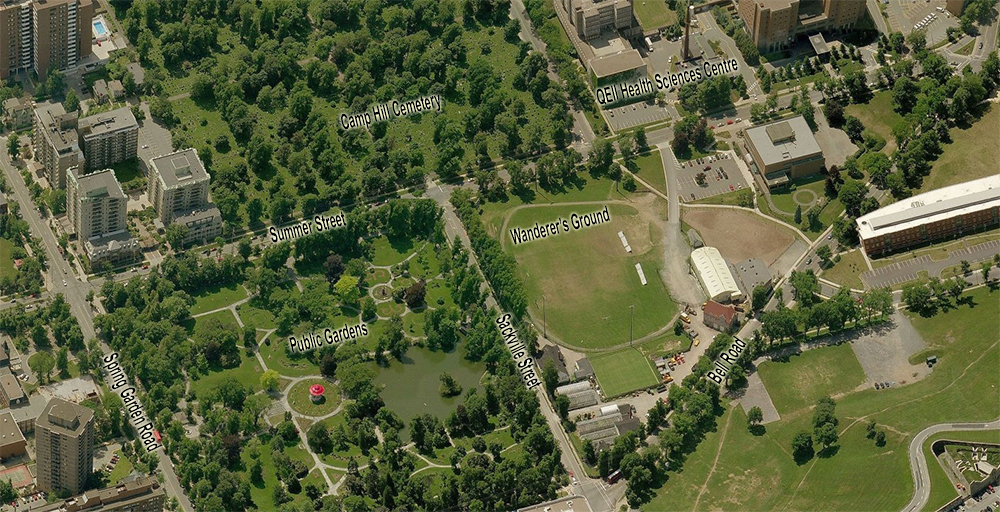
It was a very busy day at Council on Tuesday. A lot jammed in, partly because Council is going on its summer break and won’t sit again until July 18. Agenda for our June 20 meeting available here
Rinks: The major item on the agenda was the report on ice rinks. With the new Dartmouth Four-pad on track to open this September, Council was faced with choices about what to do with the older rinks that the Four-pad was built to replace: the Bowles, LeBrun, Gray and Devonshire. Staff’s recommendation was generally in keeping with the direction set out in the 2012 Long-term Arena Strategy. The motion passed unanimously by council was to declare the Bowles and Gray surplus, demolish the Devonshire but keep the land for a new Needham Community Centre, keep the LeBrun on a trial basis, and complete a more detailed analysis of the Forum retrofit to see if adding a third ice pad still makes sense when Dalhousie might build its own rink.
So how will this play out? The Gray will remain open for one more season to accommodate any potential disruptions due to needed repairs at Cole Harbour Place. The Bowles and Devonshire will close this year and demolition of the Devonshire will likely take place in 2018/2019. The LeBrun was selected to stay open on, potentially, a longer-term basis because it’s physically attached to the adjacent community centre. Staff will monitor usage, including summer sports that use the rinks when the ice comes out, before Council makes a final decision about the LeBrun.
I supported the staff recommendations because I think it struck a reasonable balance. The statistics on ice usage gathered by staff show that ice time is well used on the weekends and early evenings, but that’s not the case for other time slots. Ninety-four per cent of prime time ice is booked, but that figure declines to 50% for late evening, and just 22% for mornings. The challenge for us as a community is how much do we spend on expensive rinks to fulfill a demand that exists for four hours a day for half the year? We can’t put a rink on every corner. There are many demands on HRM for services and facilities and we need to strike the right balance. It’s not financially feasible to add the Four-pad and, at the last minute, decide to also keep all of the existing rinks, most of which are old, are expensive to operate, and need significant reinvestment. Retaining the LeBrun, given that it’s attached to another HRM facility, made sense to me as a way to keep a backup rink in circulation and gauge whether there is additional demand out there for a 25th ice surface. It’s noteworthy that after the initial disruption, the loss of the Shannon Park rink had no impact at all on HRM’s Parks and Rec usage while the Four-pad, because of the efficiencies gained in the larger facility, will actually be able to provide more hours by increased efficiency and extending the operational period. Ice time will increase even with the closures. It’s not a 1:1 replacement, it’s a gain. We’ll see how that shapes up over the next two years.



The Surplus Dartmouth Rinks: There is a strange twist to the Bowles story. As part of the process for disposing of surplus properties HRM classifies each property according to its unique attributes. The Bowles has been classified as an “extraordinary” property disposal because it’s not really available. The adjacent property owner actually has a right of first refusal, which stems from a legal settlement back in 2012. This means that he has the ability to buy the Bowles, at market value, before it can be offered to anyone else. The big problem I have with this is the right of first refusal was never approved by Council. The legal settlement fell within staff’s delegated authority so it never came to Council back in 2012. It was also never mentioned in any staff report or registered on title so it wasn’t known to the general public. This meant that the Dartmouth Curling Club needlessly spent considerable time and effort preparing to make a bid for the Bowles even though there is a good chance it won’t be available. Staff didn’t technically do anything wrong here as it was within their delegated authority to agree to the right of first refusal back in 2012, but policy doesn’t fit every situation. Even though it wasn’t required, I think that Council should have been kept in the loop before rights for a significant public asset were signed away. The future of the Bowles now depends on what the adjacent landowner decides to do. There is nothing that can be done about this now, but I’ll be considering potential policy changes over the next little while to prevent this kind of situation from ever happening again without Council’s consent.

The situation with the Gray is more clearcut. There has been interest expressed in the rink by community groups and the property has been classified as “community interest.” Properties designated as community interest are made available for non-profits to submit bids on and could, potentially, be disposed of at less than market value. I have been concerned for a long-time at what the closure of the Gray could mean for Dartmouth North as it’s a community that faces some unique social challenges and needs a little extra help. After discussing with staff though, what I have learned is the Gray doesn’t serve the immediate local community all that well. There are some limited free skates and a summer floor hockey league, but ice hockey dominates most of the time. Ice hockey is a sport that sees parents driving kids all over HRM to play and most of these folks will have no problem playing at or getting to the new Four-pad. Hockey also tends to be a sport that is out of reach for families with limited income because it’s expensive and requires a large time commitment. The idea of the community rink in Dartmouth North is attractive – the small-town rink is an enduring part of our national consicousness – but the actual reality is much more complicated and suggests the Gray is in the community, but not necessarily part of it. If the Gray were to be taken over by a community group, it might actually provide more value to Dartmouth North than it does now as an ice rink that mainly serves the broader hockey community. This is one that Councillor Mancini and I will be following closely.

Wanderer’s Ground Stadium: The other big attention getter on the agenda was the recommendation to allow a temporary stadium on the Wanderer’s Grounds (corner of Summer and Sackville Streets). The temporary stadium would house a soccer team in the new six team Canadian Premier League. I think this is an exciting opportunity for HRM and, unlike so many other opportunities, it came with no request for HRM to provide any funding. Sports Entertainment Altantic’s (SEA) ask of HRM is for the space for 14 matches over the course of the year. That’s it.
I really like that SEA’s plan has selected a Downtown location and they’re not trying to build too big (7000 seats). Both of these things matter as being Downtown maximizes the economic and civic factors, while not building too big ensures that fans won’t feel alone in a cavernous space. In the past HRM has tried to go after events that would get us a 20,000+ stadium and maybe a CFL team, but I have always been skeptical of those dreams. I’m not convinced that our population and small corporate sector provides a market that can sustain something like the CFL. SEA’s more modest plan feels right-sized and a Downtown location near transit, hotels, restaurants etc is a good spot.
There has been a fair bit of press in opposition to the Wanderer’s Ground Stadium, with the suggestion that we’re walling off the Common for private profit. It’s important to note that in negotiating a deal with SEA, HRM won’t sign over control of the Wanderer’s Ground and other field users won’t be barred. In fact, other sports activities will have the additional benefit of seating that wasn’t there before. The Wanderer’s Ground is already fenced off for booked recreational uses so no access is being taken away from the general public. This isn’t a spot that people casually walked through or picniced on. The Wanderer’s Ground also has a long history of hosting sporting events and the Commons has hosted ticketed events, like concerts, in the past. The SEA proposal has the potential to provide new life and activity to the Common and Downtown. I would be surprised if it resulted in traffic chaos since the Peninsula and Downtown manage to handle Moosehead games and special events like the Parade of Lights. If it doesn’t work, than HRM can always walkaway at the end of the contract and we’re no worse off.
For good measure, Councillor Mason added several additional conditions that I was happy to support including aesthetic requirements for the stands, partial removal at the end of season, restriction on additional uses, an 11:00 p.m. cutoff, timelines for site cleanup, requirement to work with the hospital to minimize any impacts (parking in their garage), and an ongoing review process. Councillor Mason’s amendment and the main SEA proposal passed unanimously.

Sustainable Procurement: In our packed day, a report on changing procurement processes to include requirements for local preference, social economic benefit, environmental impacts, and fair wages was also in the mix. The general idea here is to require businesses that contract with HRM to be more sustainable, provide more benefit to the municipality, and to pay their employees well. Past Council’s have looked at having a buy local policy, but the idea has always been rejected because of concerns that if every jurisdiction started adopting buy local ordinances, our little community of 400,000 that relies on exports would end up on locked out of bigger markets. The staff report, unsurprisingly recommended against a local preference, but it did recommend that a committee be struck to examine the other suggestions on social, environmental and wages in more detail.
To be blunt, I was surprised by the recommendation to do further study as I was expecting an outright no recommendation from staff because of the potential complexity and additional costs. I’m not sure where this process will lead, but I think it’s worth exploring, and it’s an issue that’s very dear to several of our new councillors. One in eight residents in HRM live in poverty and HRM is taking a more active role to try and help by getting involved in issues like affordable housing, food security, and affordable transit. Given that background, it seems only sensible to me that we also consider how HRM handles contracting. I know some advocates would have liked HRM to move faster, but as Councillor Mason pointed out, it took Toronto four years to develop and adopt their new procurement rules. These things take time. Council did amend the recommendation to require staff to report back on progress during budget deliberations in 2018. I don’t expect the work will be done by 2018, but I expect to see some significant progress.

Surveillance Cameras: Also of note, Councillor Mancini brought forward a motion to look at the use of surveillance cameras in public spaces and to consider the pathway between Albro Lake Road and Farrell Street as a location for a pilot project. The Albro Lake-Farrell pathway has been the scene of trouble in the past with a few robberies occurring on it before the recent murder of Chelsie Probert. The boundary between Councillor Mancini’s district and mine is Albro Lake Road, so the pathway is technically in District 6, but since it’s right on the line, it has been of interest to many folks in District 5 as well. The usual decorum at Council is to let the area councillor take the lead and this has been one of those times where I have been very grateful to have a colleague who works hard and does his job well. Councillor Mancini has been looking at what could be done to make the path and the adjacent Nova Scotia Power property safer for several months, well before the recent violence. I have been digging into this with him and with our local Dartmouth police officers too in light of recent events.
HRM is reviewing the 2015 Crime Prevention through Environmental Design audit that was done for the pathway and will be looking at removing vegetation and improving lighting in the area. Councillor Mancini has also been working with Nova Scotia Power to look at options for the lands that NSP owns on either side of the pathway on the Farrell Street side. I was happy to support Councillor Mancini’s motion to look at cameras for this area, but I certainly don’t want to add cameras to every public space. I don’t think they’re a great use of money and they comes with considerable privacy concerns. The Albro Lake Road – Farrell pathway though seems to be a bit of a hot spot and, in this instance, I think it’s something that is worth taking a look at.
In discussing Councillor Mancini’s motion, Council also had a broader discussion about the underlying issues in terms of crime including addiction, lack of employment opportunities, education, affordable housing, health, food security, recreational access etc. Theses are big social issues that are bigger than HRM and aren’t easy to solve. The Province has primary jurisdiction in most of these areas, but HRM has been taking a more active role over the last few years where it can. Initiatives like the mobile food market, provisions for affordable housing in new development (coming in the Centre Plan), and the low-income transit pass program have the potential to help many. HRM is also reviewing its recreation fees and working with the United Way to try and deal with homelessness and reduce the number of residents (1 in 8) who are living in poverty. While these are big problems, I’m hoping in the short-term we’ll be able to make the pathway a bit safer and reduce some of the fears felt by area residents.
Other Business:
- Increased the event grant to Tall Ships
- Approved local improvement charge for Sheet Harbour to cover the maintenance cost of the sidewalk in the village
- Granted noise exemptions for Pride and Jazz Fest
- Approved contracts for snow clearing in Sackville, new fire truckers (pumpers), paving,
- First reading on increasing fines for false alarms as we previously discussed during budget deliberations
- Set in motion process for a direct sale of surplus HRM land to Lake City Woodworkers
- First reading for changes to the tax relief for non-profit programs to more fairly (the Banook Canoe Club amendment)
- Directed Transit to hire a consultant to review the corridor routes in the Moving Forward Together Plan (our intent was apparently not quite clear the first time around?)
- Added some potential bike routes to the Active Transportation Priorities Plan

Thanks for the update Sam! Keep up the great work.
thanks for keeping us informed
The blog is great Sam. Will be a continual read for me.! ! !